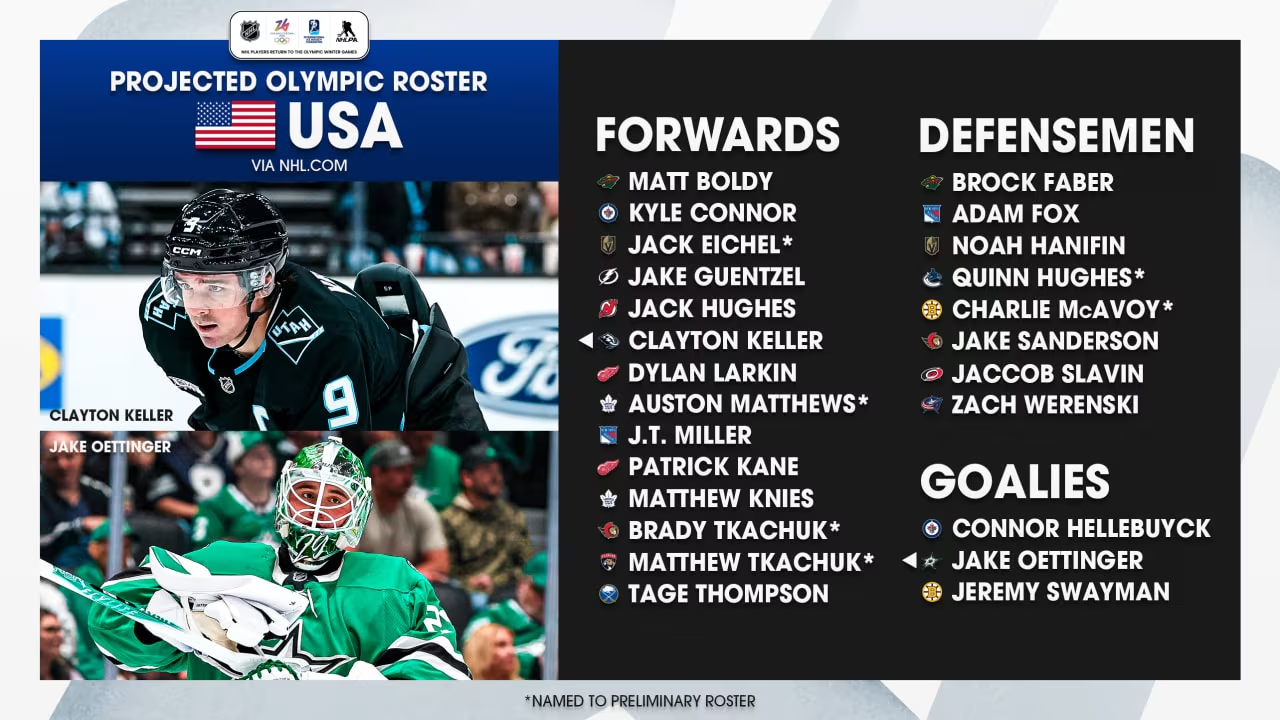The Return of the NHL: Team USA’s Projected 2026 Olympic Roster
The anticipation for the 2026 Winter Olympics in Milan and Cortina, Italy, is reaching a fever pitch, primarily because the world’s best players from the National Hockey League (NHL) are set to return to the international stage for the first time since 2014. With the Games just months away, speculation about the composition of Team USA is intense.
In a recent projection published in October 2025, NHL.com analysts offered a detailed look at the 25 players they believe will represent the United States. The roster projection successfully bridges the gap between the last generation of American hockey stars and the current crop of dynamic young talent, notably featuring veteran clutch performer Patrick Kane and Norris-caliber defenseman Quinn Hughes.
This projection provides the clearest indication yet of how USA Hockey might construct a team designed for the fast, high-stakes tournament format, prioritizing speed, skill, and versatility.
The Full Projected Team USA Roster Breakdown
The NHL.com projection names 14 forwards, 8 defensemen, and 3 goaltenders, highlighting the incredible depth the United States currently possesses, particularly on the blue line and up front. The roster is a compelling mix of established leaders and players hitting their prime.
Forwards (14)
The forward group is characterized by elite speed and scoring punch, featuring several players who have proven they can carry an offense in the NHL. The inclusion of Patrick Kane (projected to be 37 at the Games) signals a desire for proven international experience and leadership.
| Player | NHL Team | Role/Skill Set | Age (Feb 2026) |
|---|---|---|---|
| Patrick Kane | Detroit Red Wings | Veteran Leader, Clutch Scorer | 37 |
| Jack Eichel | Vegas Golden Knights | Elite Center, Offensive Engine | 29 |
| Dylan Larkin | Detroit Red Wings | Speed, Two-Way Play | 29 |
| Kyle Connor | Winnipeg Jets | Pure Goal Scorer | 29 |
| Jake Guentzel | Tampa Bay Lightning | Playoff Experience, Net Presence | 31 |
| Jack Hughes | New Jersey Devils | Dynamic Speed, Offensive Catalyst | 24 |
| Clayton Keller | Utah Hockey Club | High Skill, Versatility | 27 |
| Matt Boldy | Minnesota Wild | Rising Star, Power Forward | 25 |
| Brady Tkachuk | Ottawa Senators | Grit, Leadership, Net Presence | 26 |
| Matthew Tkachuk | Florida Panthers | Elite Power Forward, High Hockey IQ | 28 |
| Jason Robertson | Dallas Stars | High-Volume Scorer | 26 |
| Cole Caufield | Montreal Canadiens | Sniper, Power Play Specialist | 25 |
| Trevor Zegras | Anaheim Ducks | Creativity, High Ceiling | 24 |
| Brock Boeser | Vancouver Canucks | Reliable Scorer, Depth | 28 |

Defensemen (8)
Team USA’s projected blue line is arguably its greatest strength, built around elite puck-moving ability and defensive reliability. The group is anchored by Quinn Hughes, the reigning Norris Trophy contender and one of the most dynamic defensemen in the world.
| Player | NHL Team | Role/Skill Set | Age (Feb 2026) |
|---|---|---|---|
| Quinn Hughes | Vancouver Canucks | Elite Puck Mover, Power Play QB | 26 |
| Adam Fox | New York Rangers | Norris Winner, Defensive Anchor | 28 |
| Charlie McAvoy | Boston Bruins | Physical, Two-Way Force | 28 |
| Zach Werenski | Columbus Blue Jackets | Offensive D-Man, Veteran Presence | 28 |
| Jaccob Slavin | Carolina Hurricanes | Defensive Specialist, Shutdown Role | 31 |
| Seth Jones | Chicago Blackhawks | Experience, Size, Mobility | 31 |
| Owen Power | Buffalo Sabres | Young Size, Massive Potential | 23 |
| Jake Sanderson | Ottawa Senators | Defensive Reliability, Speed | 23 |
Goaltenders (3)
The goaltending position is critical in short tournaments, and the projection features three high-caliber netminders, led by a Vezina winner.
| Player | NHL Team | Role/Skill Set | Age (Feb 2026) |
|---|---|---|---|
| Connor Hellebuyck | Winnipeg Jets | Vezina Winner, Likely Starter | 32 |
| Jake Oettinger | Dallas Stars | Young Star, High-Pressure Experience | 27 |
| Thatcher Demko | Vancouver Canucks | Athleticism, Strong Backup | 30 |
Analysis: The Blend of Experience and Dynamic Youth
The most striking feature of this projected roster is the strategic balance between proven veterans and the explosive young core that has defined the NHL over the last five years.
The Kane Factor
Patrick Kane’s inclusion is perhaps the most debated element. While his offensive production remains high, his age (37) raises questions about speed in a tournament environment. However, the analysts clearly value his pedigree.
“Kane brings an intangible element that few American players possess: a history of performing in high-leverage, winner-take-all situations. His inclusion is less about filling a top-six spot for 82 games and more about having a proven closer for seven games in February,” noted the NHL.com analysis.
Kane is the only player on the projected roster with multiple Olympic appearances, having played in 2010 and 2014. His presence would serve as a vital link to past international success.
The Hughes Brothers and the New Guard
Leading the next generation are the Hughes brothers, Quinn on defense and Jack at center. Quinn Hughes represents the modern, highly mobile defenseman essential for success on the larger international ice surface. His ability to transition the puck and run a power play is unparalleled among American defensemen.
Meanwhile, Jack Hughes is the quintessential modern Olympic forward: fast, highly skilled, and capable of creating offense out of nothing. He is joined by other dynamic young stars like Clayton Keller, Matt Boldy, and Trevor Zegras, signaling a shift toward maximum skill and pace.

Defensive Depth and Goaltending Reliability
Team USA’s defensive unit is arguably the deepest in the world, rivaling even Canada’s projected roster. The eight defensemen selected are all top-pairing players on their respective NHL teams, offering coach Rick Tocchet (or the eventual head coach) immense flexibility.
Adam Fox and Charlie McAvoy provide the necessary two-way stability and physicality, complementing the offensive flair of Quinn Hughes and Zach Werenski. The depth choices, such as Jaccob Slavin and Jake Sanderson, ensure that the team can deploy shutdown pairs against any opponent.
The Goalie Conundrum
While Connor Hellebuyck is the clear frontrunner for the starting job, the competition between Jake Oettinger and Thatcher Demko for the primary backup role is fierce. Oettinger, despite his youth, has proven capable of handling immense pressure in the playoffs, while Demko offers elite athleticism.
In a short tournament, the selection committee must weigh Hellebuyck’s consistent Vezina-level performance against Oettinger’s high ceiling and Demko’s explosive ability. The projection suggests the team will prioritize proven NHL success and playoff experience.
Key Takeaways for Team USA
This NHL.com projection confirms several strategic priorities for the 2026 U.S. Olympic team:
- Speed is Paramount: The forward group is built around elite skaters like Jack Hughes, Eichel, and Larkin, crucial for the larger international ice.
- Blue Line Dominance: The defense is designed to control possession and transition the puck quickly, led by Quinn Hughes and Adam Fox.
- The Veteran Anchor: Patrick Kane’s inclusion underscores the value placed on international experience and clutch scoring ability, despite his age.
- The Youth Movement: Over half the projected roster is under the age of 28, indicating a commitment to the new generation of American talent.
- Goaltending Stability: The selection of three established NHL starters ensures reliability between the pipes, minimizing risk in the crucial elimination rounds.

What’s Next
While this projection provides a highly informed snapshot, the official roster will not be finalized until late 2025 or early January 2026. The next few months of the NHL season will serve as the final audition period for several bubble players, particularly those competing for the final spots on the fourth line and the seventh/eighth defense roles.
Players like Trevor Zegras and Matt Boldy must maintain high levels of production and consistency to solidify their spots against other strong American contenders who were not included in this initial 25-man projection. The final selection will be a major news event, setting the stage for Team USA’s quest for Olympic gold in Milan.
Originally published: October 29, 2025
Editorial note: Our team reviewed and enhanced this coverage with AI-assisted tools and human editing to add helpful context while preserving verified facts and quotations from the original source.
We encourage you to consult the publisher above for the complete report and to reach out if you spot inaccuracies or compliance concerns.

